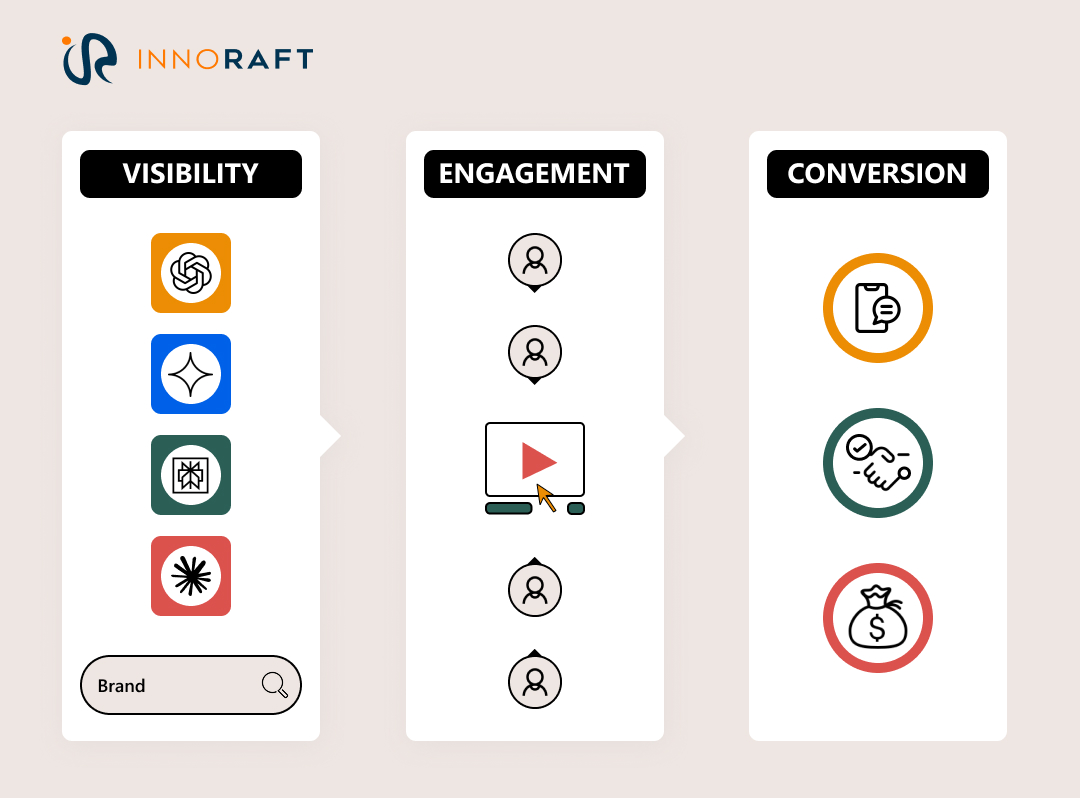Large language models (LLMs), like ChatGPT, Gemini, Claude, etc., are becoming popular. Creative-thinking marketers have started optimising content for such platforms, looking for prominence in AI-generated responses through reliable Answer Engine Optimization (AEO) strategies.
While developing Answer Engine Optimization content is becoming easier, the more challenging task is determining how to measure AEO performance. Unlike traditional SEO, which relies on specific rankings and traffic data, AEO functions in a probabilistic space—the same query may get different answers across many AI platforms, or even from the same model.
Since AI-generated outcomes are frequently non-clickable, tracking user engagement is more challenging, making AEO strategy effectiveness and results difficult to assess. In this article, we'll go over exactly how to track and analyze your AEO initiatives—what to measure, why it matters, and how to do it correctly.
AEO Strategy Effectiveness vs. SEO: What’s the Real Goal?
The goal of an Answer Engine Optimization strategy is not always to generate immediate traffic or direct conversions. Instead, it focuses on brand discovery and presence in AI-generated answers, which are critical components of AI search ranking algorithms.
Why is this important? Because users frequently don't proceed beyond the first AI-generated response. There is no need to click a link, navigate through sites, or switch between tabs. The AI provides the entire response in one go. However, this association is critical in the AEO strategy effectiveness.
Without any clicking, an AI-generated brand mention:
- Increases brand recognition.
- Builds credibility with AI's endorsed answer.
- Impacts future searches, interactions, and purchasing decisions.
That is why it is vital to measure AEO performance with solutions that track voice search performance metrics and structured data impact tracking, ensuring that your brand continues to appear in relevant responses.
Have no idea what AEO signifies? Explore our Answer Engine Optimization guide to discover more about how AEO will assist you in boosting your web approach.
Why Aren't Traditional SEO Metrics Relevant to Answer Engine Optimization (AEO)?
Search engine optimization metrics such as rankings, impressions, and click-through rates provide a precise performance map. These depend on predictable systems, which indicates that if your site ranks first today, it will most likely rank first tomorrow unless anything changes significantly.
However, AEO strategy effectiveness cannot be determined in the same way. Answer Engine Optimization is powered by large language models (LLMs), which leverage probabilistic approaches, making results less predictable. That is why it is critical to learn how to audit your AEO strategy with adaptable metrics.
Unlike SEO, AEO provides a couple of obstacles:
- The responses vary depending on the model's learning and external online sources.
- The outcomes are not fixed or consistent.
- Answers can lack clickable links, making it challenging to measure AEO performance.
That is why Answer Engine Optimization performance must be assessed differently. You're evaluating more than just traffic and rankings; you're also looking at presence, significance, sentiment, and how those factors affect user behaviour in the long run. In the future of SEO, a thorough understanding of AI search ranking factors can help you focus your optimization efforts in an AI-powered search context.
Which AEO Performance Metrics Are Important to Track?
Here are several indicators that can assist you in effectively measuring AEO performance and evaluating AEO strategy effectiveness.

Visibility Metrics
Visibility is the cornerstone of every effective Answer Engine Optimization strategy. These metrics help you determine how frequently and prominently your brand comes up in AI-generated answers.
Score for the Brand's Visibility in ChatGPT, Gemini, and Other Platforms
This indicates the frequency with which your brand appears in category-relevant AI responses. For instance, even if there isn't a click, your brand will undoubtedly win if you ask Gemini, "What's the best task management tool for teams?" and it ranks among the top three. With AEO analytics tools, keeping track of this is crucial.
Placement or Priority in LLM Responses
Are you listed first, last, or in the middle? Stronger brand authority is frequently indicated by higher positioning. Positioning in AI-generated responses is an important indicator related to AI search ranking factors.
Brand Sentiment in AI Responses
LLMs learn through web content such as reviews (G2, Capterra), discussions (Reddit), and publications. A positive state of mind improves the possibility of favourable mentions. Tracking sentiment increases brand perception in voice search performance measurements while also supporting structured data impact tracking.
Engagement Metrics
A lot of the brand discovery and evaluation occurs within the AI interface, before a user even reaches your website. As a result, while total website traffic may fall, traffic quality is expected to improve. Users who click through have already done some research using AI, so they are more informed, curious, and ready to interact. This results in higher-quality sessions on your website.
To measure this efficiently, focus on the engagement metrics listed below:
- Bounce rate: Do visitors stay around or leave immediately?
- Time spent on site: Do they read your content in depth?
- Pages per session: Do they engage on several pages?
Engagement metrics seem to grow as your brand's visibility and positive perception increase. For instance, if a shoe company's popularity for "best running shoes" increases throughout AI searches, they should expect higher engagement on their running shoe product pages—across all traffic channels, organic, direct, and paid.
Conversion Metrics
As AEO impacts mostly the top of the funnel, it is vital to track its impact on downstream conversions. You may have observed that various AI platforms (such as ChatGPT) are now showing up in your website analytics as referral sources, usually with UTM parameters like utm_source=chatgpt.com. As traffic to these LLM-powered sites develops, you could see a boost in bottom-of-funnel statistics, including
- Actions performed (form submissions, demo requests, or product views)
- Completed actions (submit lead forms, make purchases, or arrange demos)
- Live chat interactions
- Product support queries
- Direct revenue produced
Conclusion
A flawless AEO strategy can help your business rank in search engine results, driving visitors to your website and increasing conversions. AEO, like SEO, can be intricate and may require professional support to fully optimize the strategy. As AI-powered search evolves, the businesses that adapt first—and focus on AEO strategy effectiveness—will lead the way. Traditional SEO metrics no longer provide the complete picture; instead, AEO analytics tools, voice search performance metrics, and structured data impact tracking—combined with content optimization for search engines—are fundamental for success.
Innoraft can help you identify significant opportunities, develop your content strategy, and increase exposure in today's search-driven industry. Get started today, and with AEO as an element of your digital marketing toolset, you'll only move higher.
FAQ
Frequently Asked Questions
To measure AEO performance, track:
- Visibility in AI-generated responses
- Brand perception in such responses
- Your position or significance in the LLM answers
To understand how to audit your AEO strategy, read:
- Your brand's inclusion and placement in AI answers
- Considerations for structured data quality
- User sentiment
- Performance in voice and zero-click search contexts
Didn’t find what you were looking for here?




